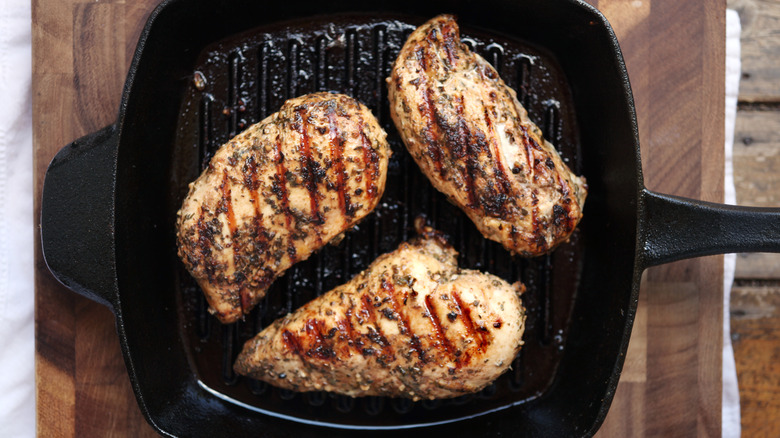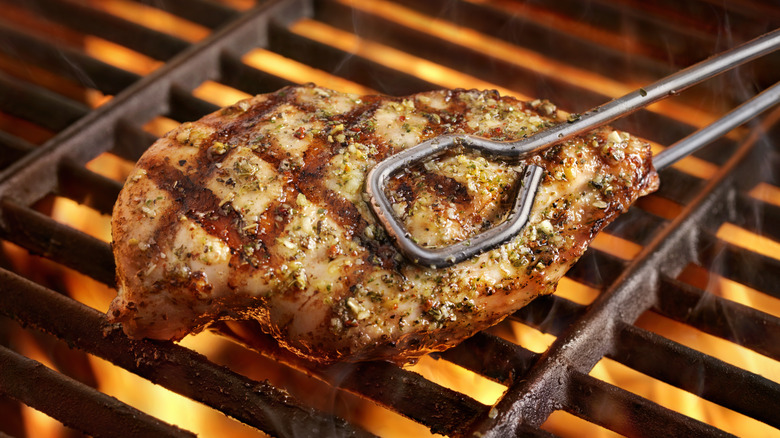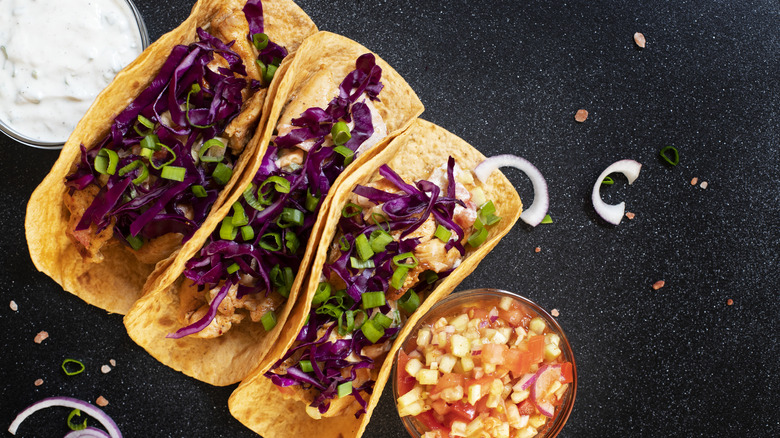The Biggest Mistake You Can Make When Flipping Chicken
Most of us have lost a fight with chicken when it seems to be welded to the pan. It's frustrating, especially when it feels like you've done everything right. You started the bird in a hot pan, added plenty of fat, and yet, when you try to flip it over, it's stuck. Instead of panicking or hacking away at the poultry with a spatula, try something new. Simply leave it to cook longer.
Trust in your pan (or grate). Don't pry the thighs from the metal before they're ready and sacrifice all that good flavor. You'll lose precious juices, meat, and skin — not to mention your meal will look rough around the edges. Instead, try to learn from what your skillet is trying to tell you.
Once the chicken is nicely seared, the meat will naturally release from the surface. If it's stuck, you're likely trying to flip it too early. Stay patient, and you'll be rewarded for waiting with a browned exterior and easy turning.
Unsticking chicken from the pan
As chicken cooks, its proteins will bond with metal surfaces, which is why it feels impossible to separate the two from each other. But once the exterior begins to brown, a sign of the Maillard reaction, those proteins start to break down and transform into aromatic deliciousness. It's then that the breasts and thighs will release from grills, stainless steel, and cast iron all on their own.
To set yourself up for success, you can prepare by tempering your chicken, which just means taking it out of the fridge ahead of cooking it to shake the icy chill. Fat is also an essential barrier between your dinner and your cookware, so make sure you've lubricated the pan before you start to sear the meat. And don't forget to let your pan preheat — especially cast irons, which need extra warming time.
The bird will also brown better if there's less moisture around, so make sure to pat each piece dry before cooking and avoid crowding the pan, which will cause steaming. Pro tip: You can even keep prepared pieces uncovered in the refrigerator for a few hours to let the skin dry out. If your spatula won't make any headway after multiple checks, you can try adding more fat to the pan or adjusting the temperature a smidge.
Making the most of grilled and seared chicken
Once you've waited to flip your chicken, the rest is easy. The real challenge comes when determining how to use the juicy protein. If you're preparing your meat on the grill, we recommend setting a smoky piece or two aside to layer into salads later. To make meal prep a breeze, use mason jars, Martha Stewart's secret for the best make-ahead salads.
If pan searing is more your style, consider making a sauce with all the caramelized brown bits that your chicken released. Those morsels, called fond, pack a lot of flavor. Once you've removed the cooked meat, deglaze the pan with a glug of wine or stock. All those chicken scraps will dissolve into the liquid and form the base of a gravy.
Perhaps your kitchen practice left you with leftovers. There's no better excuse to mix up the pieces into a creamy chicken salad, or shred pieces and add them to a warm chicken soup. You can also pair poultry bits with cilantro, onions, and a punchy sauce for a makeshift taco, or combine it with your gravy and bake up a pot pie.



